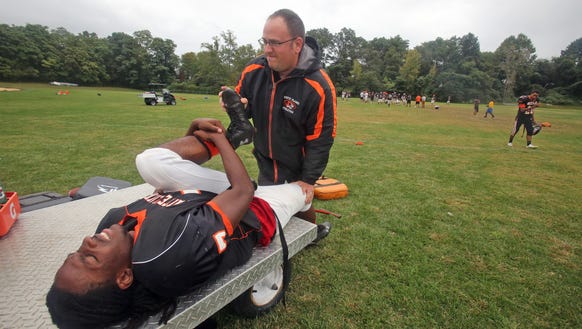 Carolyn's Corner
Carolyn's CornerVersión en español aquí.
By far the biggest story in high school football this week was the death of a player during a game. Not for the sensationalism, but rather what it points up about player safety. The whole country is devastated, particularly because nationally, this is the 3rd death in September alone.
On September 25, a 17 year-old quarterback for Warren Hills Regional High School in New Jersey, Evan Murray, took a hard hit on the field that resulted in a lacerated spleen. While he was conscious on the sideline before leaving in an ambulance, he later died due to internal bleeding. His death was ruled an accident since it was found that he already had an enlarged spleen, which made him more susceptible to injury.
However, it is still a sobering reminder of the dangers of football at any level and a reason to review just what measures are in place to prevent as much as possible. Furthermore, despite the risk of injury, high school football attracted more participants than any other sport--1,085,182 last year-- according to the National Federation of State High School Associations. While the potential for loss of life is small--according to a 2013 study there was an average of 12.2 deaths per year from playing high school and college football-- everyone would agree, nevertheless, that even one life lost is too high. And injuries of all types and severity are prevalent.
So just what measures are already in place--for all types of injuries? At the very least, in many states, all coaches at all levels, including assistants and volunteers, are required to have CPR, First-Aid, AED (Automated External Defibrillators) and Concussion Protocol Certification. This is a good start.
Now, in addition, a new trend is emerging. On the high end, In White Plains, New York for example, varsity (top-tier team) games have an Athletic Trainer, the school's Medical Director (a pediatrician) and the Team Physician (an orthopedist) present at all games, as well as an ambulance at least on stand-by. Although this solution carries with it the old Achilles heel of money/funding, it is a level to strive for.
Even the addition of a part-time trainer can make an impact, many say. There are many creative scenarios for making it happen. Sometimes individual schools share a trainer's services, sometimes districts have one or two scheduled for all games, sometimes funds are raised by communities to pay them. Furthermore, many doctors, if asked, might volunteer their services in any number of ways to a school or district. It is all certainly worth investigating practically and legally.
Doctors and coaches everywhere usually treat football injuries with extreme care. Wouldn't it be wonderful if they had even more tools to make the game even safer?
(This might also prove to be invaluable information for other countries where American football is gaining in popularity.)
 |
| A player who suffered a leg injury in a game being attended.--courtesy of lohud.com |





0 comentarios :
Publicar un comentario